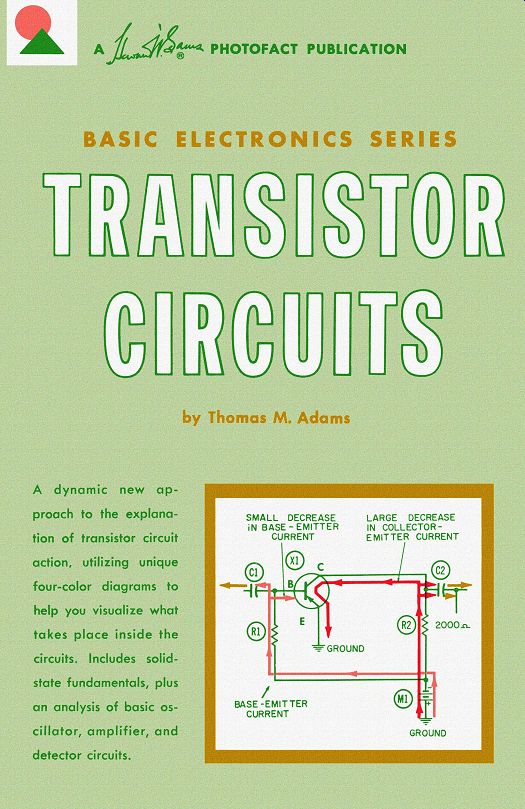AMAZON multi-meters discounts AMAZON oscilloscope discounts

A dynamic new approach to the explanation of transistor circuit action, utilizing unique four-color diagrams to help you visualize what takes place inside the circuits. Includes solid state fundamentals, plus an analysis of basic oscillator, amplifier, and detector circuits.
+++++++++
CONTENTS
SECTION 1--TRANSISTOR PHYSICS SIMPLIFIED
SECTION 2--THE THREE BASIC CONFIGURATIONS
SECTION 3--Oscillator Circuits
SECTION 4--AMPLIFIER Circuits
SECTION 5--DETECTOR Circuits
PREFACE
Even though the transistor is only slightly more than a decade old--just coming into its teens, so to speak--there is already a wealth of literature available on its circuits and applications. However, most of this literature requires considerable prior knowledge on the part of the technician or student in order to be understood.
The basic concept of this guide is that if the reader can visualize the flow of electron currents within a transistor circuit, he can comprehend the operation of that circuit. This same technique was used in the three previous volumes of this "Basic Electronics" series devoted to vacuum-tube circuit actions. The diagrams in this guide, as in the others, illustrate circuit actions rather than merely circuit connections. The configurations are fairly standard and widely used. Enough of them are presented so that the reader can apply the same analytical techniques to any transistor circuit he may encounter.
The discussions and explanations of what happens inside transistors are oriented almost exclusively around causes and effects of external actions. In other words, in analyzing circuit operation, the emphasis is on electron currents rather than on hole currents ( which move in the opposite direction from electrons) . The concept of hole currents in solid-state physics is valuable to designers and physicists. However, the results of hole current within a transistor can be analyzed in terms of external electron currents. Therefore, the concept of electron-current flow--which in the past has served admirably in helping readers understand vacuum-tube circuit actions--continues to be the best available tool for analyzing and understanding transistor circuit operation.
This guide is devoted almost entirely to helping the reader understand circuit actions. Since an understanding of these actions is essential in the education of both technicians and graduate engineering students, the text is considered neither too advanced for high-school or technical-institute use, nor too elementary for college level.
The author is indebted to the many educators in the Washington area (named in the Preface to Oscillator Circuits) for taking the time to review some of the early drawings for this series, and for making many helpful suggestions. Additionally, another debt of gratitude is owed my wife, who has been patience personified during the production of these volumes.
-THOMAS M. ADAMS; February, 1962
Also see:
Using Scopes in Transistor Circuits (1968)
Practical TRANSISTOR Servicing (1967)
Principles Of Transistor Circuits [1959]
Audio Amplifier Construction Guide (1983)